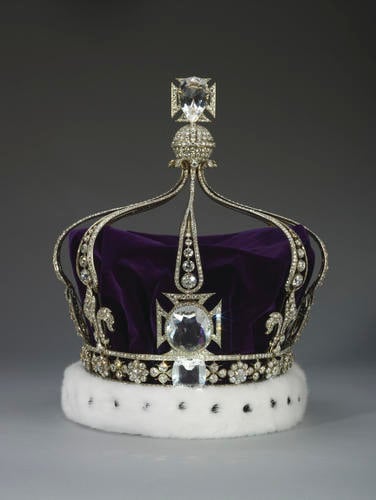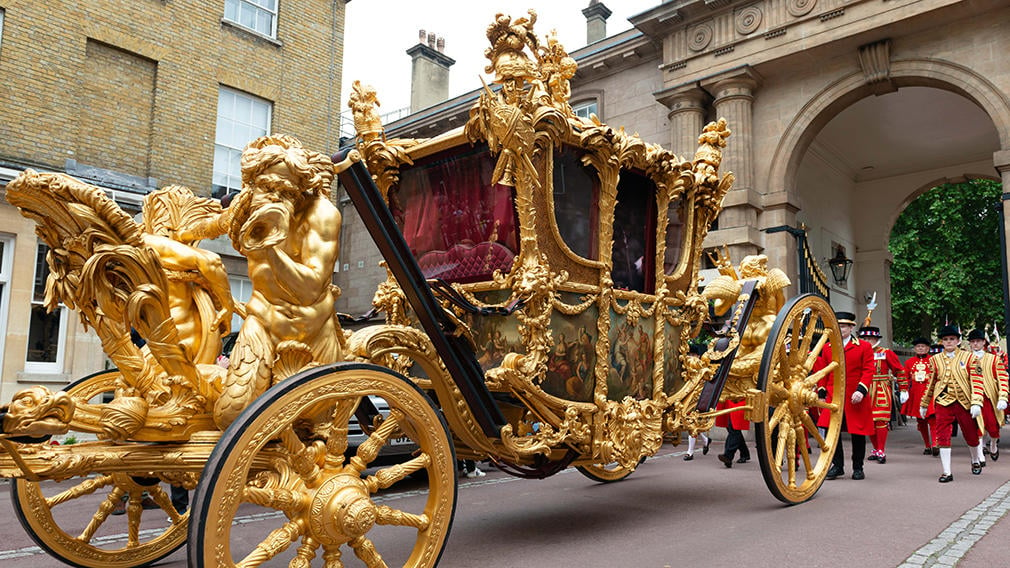We’re just days away from the coronation of King Charles III and anticipation is brewing.

Crowns are being resized, jewels polished, carriages oiled and an army of security is being stationed around the city.
The Royal Family has been promoting a more “sustainable” event — a smaller guest list, a shorter parade and an austere and affordable “coronation quiche” — all in keeping with King Charles’ vision of a “slimmed-down” monarchy.
But as the May 6 ceremony grows closer, many are wondering just how sustainable an event like this can be, when thousands of diamonds, precious gemstones and other extravagant displays of wealth will be paraded before a country (and a world) that is in the midst of a cost-of-living crisis.
Recent polling conducted by British firm YouGov shows that while the majority of Britons still support the monarchy, a growing minority believe the Royal Family has become a costly relic.
And while the U.K. government foots the bill for coronation ceremonies, it has remained mum on the sum of Saturday’s festivities, telling The Washington Post that those figures will be released at a later date.
Forbes reports that Elizabeth II’s coronation cost about 1.57 pounds million at the time, which would equal about C$78 million today. The Sunday Times estimates that this coronation will cost about C$170 million.
Another poll, also conducted by YouGov, found that more than half of the 4,246 Britons surveyed don’t believe taxpayers should be footing the bill for Charles’ coronation.
Cost-of-living crisis aside, the reluctance of the British people to pay for the coronation celebrations is understandable. The Royal Family has remained fairly secretive about their financials, and there’s no definitive grasp on how much wealth resides in the family’s royal coffers.
The Sunday Times Rich List, posted last month, estimates that the King has a personal net worth of 600 million pounds (approximately C$1 billion.) A recent investigation by The Guardian estimates his fortune could be closer to $1.6 billion pounds (C$2.7 billion).
Time and again the public sees the painstaking effort the Royal Family will expend in the name of upholding centuries’ worth of tradition. While the format for weddings, coronations and funerals may feature small adjustments, the family rarely departs from familiar (and often expensive, over-the-top) customs, symbols and institutions, despite the cost or the optics.
Despite Charles’ directive to put together a pared-down coronation, here are some of the symbols of extreme wealth within the Royal Family and on display at the coronation that will be hard for the world to ignore.
Charles’ crowns
Charles is expected to wear two crowns — yes, two — during the coronation ceremony at Westminster Abbey.
The first, St. Edward’s Crown, will be used at the very climax of the ceremony and will be placed on Charles’ head at the “moment of coronation,” according to the Royal Collection.
It is made from solid gold and is adorned with 444 semi-precious stones. Queen Elizabeth II once said its nearly five-pound weight is enough to break your neck if you bend forward while wearing it. “Heavy is the head that wears the crown,” or so they say.
In a true sign of the times, Buckingham Palace announced last month that the crown was the source of inspiration for a new emoji that appears automatically in tweets when specific hashtags are used.
The crown, in its current form, dates back to the coronation of Charles II, who was crowned king in 1661.

Get daily National news
The second crown to be worn by Charles on May 6 will be the Imperial State Crown, which is lighter, but no less extravagant. The Imperial Crown, which is often used for formal occasions, is decorated with a staggering 2,868 diamonds.

It will be worn by the new king during the final procession from Westminster Abbey to Buckingham Palace, as he travels in the Gold State Coach. It will also be visible from the Buckingham Palace balcony when the King joins other members of the Royal Family for the infamous wave to supporters.
Gold State Coach
Speaking of over-the-top tradition, the aforementioned Gold State Coach is one of the most recognizable symbols of excess the Royal Family has in its arsenal.
Described as “a dazzling, living part of British history,” it was last seen in public during the queen’s Platinum Jubilee parade.
Built in 1762, it’s been a familiar sight at every coronation since 1831. And while it’s not made of solid gold (rather, it is comprised of giltwood, a thin layer of gold leaf over wood) it’s heavily ornate, with velvet and satin upholstery and lining, painted panels of Roman gods and goddesses, and sculptures of massive tritons over each wheel.
In fact, the coach is so heavy and ornate that it takes eight horses to pull it and it can’t be moved at more than a walking pace. It is also suspended on leather straps, meaning it’s not exactly a smooth ride. The queen famously described the bumpy ride and lack of climate control as “horrible.”
Thus, Charles and Queen Consort Camilla have opted to only take the coach ride in one direction, leading away from Westminster Abbey back to Buckingham Palace.
An embattled sceptre
The king will also carry two — again, yes, two — golden, jewel-encrusted sceptres. The Sovereign’s Sceptre with Cross symbolizes the monarch’s temporal power and includes the controversial Cullinan I diamond. He will also carry the Sovereign’s Sceptre with Dove, signifying his spiritual role.
The Royal Family’s Cullinan diamond collection, which was part of the late Queen Elizabeth’s personal collection, was cut from a larger gem mined in South Africa in 1905 and handed over to the family by South Africa’s colonial authorities.
Demands for the return of the diamonds, along with calls for repatriations, have intensified since the queen’s death but the Crown has never made any declaration or shared an intention to return the diamonds, nor any of its Crown Jewels.
Camilla’s controversial adornments
Camilla will also feature prominently in the crowning ceremony, but the adornments she will be afforded that day, too, are nothing short of controversial.
She will be crowned with Queen Mary’s crown – an elaborate, gold-lined, silver frame headdress featuring 2,200 diamonds, including Elizabeth II’s Cullinan III, IV and V diamonds, which are 94.4, 63.6 and 18.8 metric carats, respectively.

Camilla will also hold a sceptre made of ivory, a decision that’s attracted some controversy, as Prince William has campaigned against the ivory trade.
The Stone of Destiny
The Stone of Destiny, a.k.a. The Stone of Scone (pronounced ‘scoon’), is an oblong block of pale sandstone and an ancient symbol of Scotland’s monarchy.
It will be visible coronation day under Charles’ 700-year-old coronation throne, after embarking from its home in Edinburgh Castle late last week in an elaborate ceremony.
Although it’s not particularly flashy, it’s another example of the stranglehold that tradition seems to have over European monarchs. It was once used for the inaugurations of Scottish kings hundreds of years ago, until it was seized from Scone Palace, Scotland in 1296 by King Edward I of England.
In 1996, England gave the stone back to Scotland, but continue to use it for coronation ceremonies.

It was thought by many to be the stone Jacob laid his head upon in biblical times, until geologists discovered that it originated from Scotland.
Other symbols
Throughout the coronation festivities, viewers will catch glimpses of a multitude of other symbols that are steeped in history and encrusted in jewels.
The Sovereign’s Orb will be spotted during the King’s investiture, placed in his right hand as a representation of his power and a reminder of Christianity.
Bands of jewels divide the orb into three sections representing the three continents known in medieval times.

It may look quite simple when juxtaposed with the crown or coach, but don’t be fooled. The orb features clusters of emeralds, rubies and sapphires surrounded by rose-cut diamonds, as well as single rows of pearls. A cross on the top is set with rose-cut diamonds, with a sapphire in the centre on one side and an emerald on the other, and with pearls at the angles and at the end of each arm.
During the ceremony, Charles will also be presented with the Golden Spurs. No, he won’t be cosplaying cowboy in Westminster Abbey — the spurs are a tradition that date back to the 1189 coronation of Richard I. Meant to symbolize knighthood, they are one of the many coronation ornaments that will be presented to Charles and then placed on the altar before he is crowned.

Is now the time for such pomp and pageantry?
High interest rates, inflation and energy prices are currently gouging Britons’ pocketbooks. Record numbers of British families are using food banks and one-in-five Britons live in poverty.
The country is also coming to terms with the history of imperialism and colonialism of long-standing monarchy, increasingly opening its eyes to the stories of pain and suffering that hide behind the Crown Jewels.
Will the pared-down coronation be enough to bridge the gap between the country’s imperial past and Britian’s lived reality? Only time will tell.













Comments